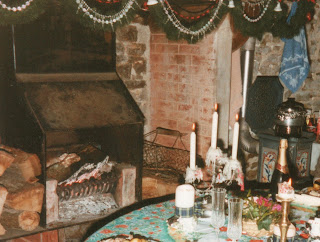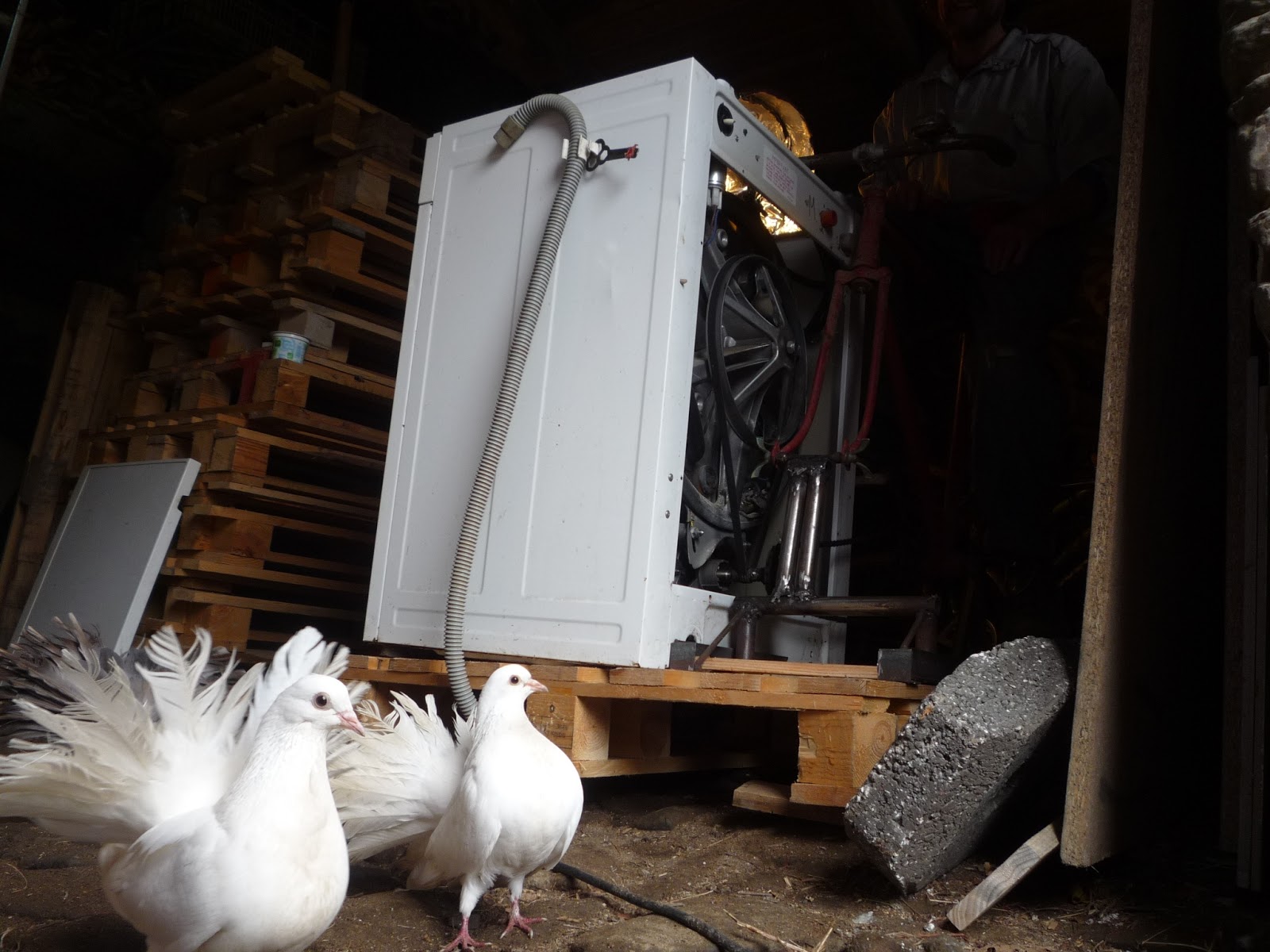Why we chose wood
 |
| Simple primitive living, when we started our new life in France Christmas 1999 with our plum pudding cooking on the Godin. |
Winter is rapidly approaching and inevitably folks are thinking about heating their homes. When we first arrived here the Spartan heating was a massive granite fireplace, the chimney of which, 1.70m by 0.70m, was blanked off and a crudely made open-fronted firebox. This had a swan's nest grate sitting in the centre of the hearth, with its flue passing through a hole in the blanking-off plate. There was plenty of wood-fuel left by the previous owner in the outbuildings, so for the first few visits here, this crude open fire became our sole source of heating and cooking. After all, you can’t carry kitchen appliances on a motorbike.
When we began to live here permanently and renovate our house, we bought an insert, a made-for-store Godin from a DIY Superstore and fitted it into the fireplace using blocks, which we then covered with decorative tiling. This looked like a Swedish ceramic stove but the output fuel-to-heat was poor and we were still reluctantly using an electric hot plate and mini cooker. After having returned the malfunctioning hotplate to the store for the 9th time, we decided enough was enough. We therefore, began to research woodburning cookers as a possible heat and cooking source. By now we had fully insulated the bare stone of our kitchen with hemp and lime and were not really wanting to break through this to install water pipes, so we went for a cooker without the advantage of a wraparound boiler. We also wanted something with glass windows so we could check on the cooking and ;have the cheering effect of the flames. Firewood is plentiful here, although year by year the price rises significantly. However, we are neither of us happy with burning magnificent oaks and beeches and we realised we could easily collect a supply of pallet wood to keep us going throughout the year. To this end our heating bill for the past three years has been zero.
Using the top of the cooker to heat water, combining this with a solar shower bag in summer and the creation of our own bicycle-powered washing machine, means we are now consuming 85 kWh of electricity every month at a cost of around 7 Euros. We have therefore, reached the point where we should quit the Grid but our house is on the market and unfortunately this has to be a consideration.
So what does our wood burning cooker do for us?
 Heats all our hot water,
Heats all our hot water, Cooks all our food
Dries fruit, flowers, vegetables and herbs
Dries clothes
What electrical appliances did we get rid of?
 Hot plate
Hot plateMini oven
Toaster
Kettle
Bathroom heater
200 litre immersion heater
hair dryer
iron
Our woodburner is not recommended by the manufacturer as a pallet-burner but some makers do promote this viz., Esse. The only problem we have found is that the flueways within the cooker need clearing of soot twice a year instead of annually when the chimney liner is swept. We also now have the little Godin stove (seen in the above photo) in our sitting room and this also heats the bedroom above it.
How to chose a Wood-burner
 |
| Our woodburning cooker with the now rarely-used insert. |
We chose a Lincar, which was made by a company which had started up in business as a manufacturer of wood-burning cookers and then gone into the manufacture of wood-stoves. Most firms we looked at had started with stoves and then gone into wood-cookers, we also found that often they did not manufacture the cookers they sold. It is very important to check the labels on the back of wood-cookers so as to ascertain who makes them and where. This way you can check the full specs, designs and prices at source. The firm, we chose had an extra commendation for us, in that it also made cookers for the Catering Industry. We bought it over the internet, which was worrying, as we had no prior experience in this. It was also impossible to find a showroom nearer than the Italian border where we could actually see the cooker. Another problem was, that in 2008, when we bought the cooker there were very limited reviews of wood-cookers on the internet. However, the company we bought ours through was a small family concern and the person we dealt with had excellent technical knowledge and we had managed to build up quite a rapport with her before we finally bought it. She was also able to provide good quality stove piping direct from the factory and free delivery of the cooker from Italy to France. Hey, we even got a free oven mitt!
Combined with buying our wood-stove the most important thing we did was to fully insulate the house. How we did this with ecological materials is the next chapter of this blog. I will also be writing a piece on how we sourced and made our bicycle washing machine.
What happens in Summer?
 In the hotter months we still use the wood-cooker but only at meal times. Having espoused a French way of life we have a main cooked meal at lunch-time and a cooked meal in the evening, we also have a cooked breakfast. To provide hot water throughout the day I constructed a pallet wood hay box which keeps the water hot for the hours between lighting the cooker. To heat up a kettle we also use a home-made rocket stove. I found the information how to make one of these on Youtube but I have since found that the wood-gas burner, which you can make from similar recycled materials is more efficient but I have yet to make one and verify this.
In the hotter months we still use the wood-cooker but only at meal times. Having espoused a French way of life we have a main cooked meal at lunch-time and a cooked meal in the evening, we also have a cooked breakfast. To provide hot water throughout the day I constructed a pallet wood hay box which keeps the water hot for the hours between lighting the cooker. To heat up a kettle we also use a home-made rocket stove. I found the information how to make one of these on Youtube but I have since found that the wood-gas burner, which you can make from similar recycled materials is more efficient but I have yet to make one and verify this.
 In the hotter months we still use the wood-cooker but only at meal times. Having espoused a French way of life we have a main cooked meal at lunch-time and a cooked meal in the evening, we also have a cooked breakfast. To provide hot water throughout the day I constructed a pallet wood hay box which keeps the water hot for the hours between lighting the cooker. To heat up a kettle we also use a home-made rocket stove. I found the information how to make one of these on Youtube but I have since found that the wood-gas burner, which you can make from similar recycled materials is more efficient but I have yet to make one and verify this.
In the hotter months we still use the wood-cooker but only at meal times. Having espoused a French way of life we have a main cooked meal at lunch-time and a cooked meal in the evening, we also have a cooked breakfast. To provide hot water throughout the day I constructed a pallet wood hay box which keeps the water hot for the hours between lighting the cooker. To heat up a kettle we also use a home-made rocket stove. I found the information how to make one of these on Youtube but I have since found that the wood-gas burner, which you can make from similar recycled materials is more efficient but I have yet to make one and verify this.
 This image shows our hay box in construction, I completed it with a pallet wood finish to hold in the hay and an insulated lid. Within the box water will keep hot for 4 hours and stay warm for up to 8 hours. This box can also be found as a Victorian cooking technique in Mrs Beeton's Book of Household Management published in 1875.
This image shows our hay box in construction, I completed it with a pallet wood finish to hold in the hay and an insulated lid. Within the box water will keep hot for 4 hours and stay warm for up to 8 hours. This box can also be found as a Victorian cooking technique in Mrs Beeton's Book of Household Management published in 1875.
Below are two of our more recent designs for a hay box. The first, a simple cheap and cheerful cardboard one (pictured below) and the second a more sophisticated pallet wood one. There is also a film of our trip to the beach in Winter, where we test both designs!
Factors to consider before you decide what energy requirements you need;
1. Be brutal. Start by cutting consumption, this is easier than creating energy.
2. What are your strengths. i.e., what energy sources are plentiful?
3. What are your needs – heating, cooking, hot water, drying, lighting ……
4. Budget and capital expenditure, including maintenance costs.
5. Personal strengths/skills
Wood is cheaper in large volumes but these will need sawing, carrying and storing. Solar, wind, geothermal and wood are cheaper if you can install your own systems.
6. Continuing education
Ask around, look what other people are installing, also visit Fairs and Salons/Exhibitions on Organic and Alternative Living. There are now more opportunities than ever for residential and day courses on alternative energy
A taste of something better - Guichen (Brittany) Salon Bio 2011 - Organic and Green Living Fair. These types of fairs are held yearly all over Europe.
All the best and thanks for dropping by. If you enjoyed this article feel free to share it, comment and/or ask questions.
Cheers, Andy
© Andy Colley 2014



